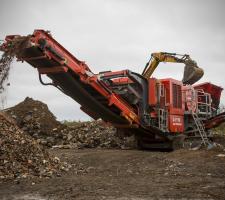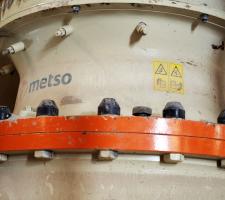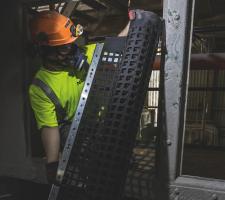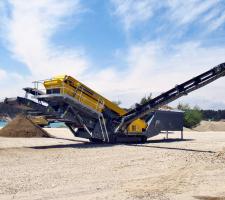
New crushing and screening equipment is being introduced and is at work in quarries worldwide, as Patrick Smith reports.
The Rammelsbach quarry in Germany has reserves for at least 20 years, and has just invested in a new Nordberg GP330 cone crusher, the first of its kind in the country.
Dating from the 1860s when the first extractions were made, it was the biggest quarry in Europe in the 1930s, and since 2001 it has been owned by Basalt-Actien-Gesellschaft (BAG), one of Europe’s biggest aggregates and building materials producers.
“Reliability of operation is clearly the number one target for us. With our new Nordberg GP330 cone crusher we have secured a trouble-free, continuous secondary crushing process that enables us to produce daily some 4,000tonnes of high-quality aggregates,” says Kurt Schön, production manager of BAG Rammelsbach quarry.
“During the first year we have crushed with the GP330 over 1,800 hours. Everything has gone well, and all targets set for the end product quality and capacity have been met.
“Thanks to the IC50 process automation, everything in the crusher functions can be adjusted easily. To secure the non-stop operation in the future, we have signed a five-year equipment protection plan with
In Rammelsbach, microdiorit named Kuselit after the nearby village, is extracted and this rock has a solid density of 2.68, making it well suited for production of high-quality railway ballast. Some 50% of production goes to DB (German Railways) for nationwide use.
“Everything we do here is documented accurately. Of each 1,000tonne shipment of railway ballast, a sample is taken. Each stone we produce must follow the quality standards by both size, cubicity and purity,” says Schön.
“In our production totally, we have six different research phases.”
Within the quarry process, the microdiorite is blasted and trucked first to the primary gyratory crusher, after which it is screened into three different sizes: 0-32mm size is separated, and a suitable mixture of 32-70mm and 70-240mm is fed into the Nordberg GP330 cone.
The crusher has a 34mm closed side setting (CSS) and 22mm stroke, providing cubical, 0-80mm sized aggregates for further processing.
The constant capacity processing the hard microdiorite is around 340tonnes/hour and, being abrasive, crusher wear parts are changed after each 1,900 operating hours, while the new Metso offline oil filter is said to be multiplying the lifetime of hydraulic oil and saving money.
Meanwhile,
Indeed, the company says the launch of its H6e cone crusher continues the expansion of its track-mounted machines for final grain products. As with the Keestrack H4e (weighing approximately 46tonnes, capacity of up to 250tonnes/hour), the new 62tonne fully hybrid machine has a diesel-electric drive concept.
Able to produce up to 400tonnes/hour, the maximum feed size of 215mm and variable crushing chamber configurations and stroke settings enable it to offer a CSS range from 6-44mm.
The crusher is driven by a 220kW electric motor, while the lubrication system; the hydraulic Hydroset control with overload cut-out, and the air compression of the crusher housing are powered by separate electric motors/pump units. All crusher functions are incorporated into the central Keestrack PLC controller, which also enables loading personnel in excavators or loaders to operate the machine by means of a remote-control unit.
As an option, the Keestrack-er telematics software system documents all the key performance data of the crusher in real-time
A 345kW
Keestrack says that following its fully hybrid H4 cone crushers and B4e jaw crushers, it is introducing the R5e hybrid impact crusher unit, following a series of upgrades.
The R5e is a diesel-electric version of its 350tonnes/hour all-round model, and like the larger R6e impact crusher, it has a 5,100kg rotor driven directly via the 345kW Volvo six-cylinder diesel engine.
Keestrack says that the operating hydraulics power all the lifting cylinders on the chassis and conveyor belts; the track drive; vibrating discharge chute and double-deck primary screen, and the compact double-deck post-screen module with oversize/stockpile conveyor.
A 160kVA generator now supplies the power to all other conveyor systems, including the 5m³ vibrating feeder, and the new Keestrack Neodym overbelt magnets (option).
Meanwhile,
The ease of material flow through the machine is said to have greatly improved with each component increasing in width as the material travels through the unit. The provision of extra width is now part of a new engineering ethos that Terex Finlay is applying to all new machine models.
Incorporating a new Terex crushing chamber, advanced electronic control system and a quick detach 3.66m x 1.53m two-deck screen, the I-120 is undergoing testing at a Terex Finlay customer’s limestone quarry in Manorhamilton, County Leitrim, Ireland, prior to its launch.
The company has also started testing a new pre-production, second generation 684 inclined screen which features new conveyors; new conveyors’ folding mechanism, and a wider screen box, and this is due to go into full production in March 2018.
A Terex Finlay J-1170 jaw crusher is processing inert waste in Morpeth, county Northumberland, north-east England, brought to the site from demolition sites across the region.
Sanders Plant and Waste Management, a family-owned recycling and plant hire company, previously hired crushers but bought its first crusher from Finlay Plant Northern after having it on demonstration.
At a rate of 120tonnes/hour, the 48.8tonne tracked primary crusher, featuring a hydrostatically-driven Terex jaw chamber, is crushing material to 50mm as well as separating the fines.
EvoQuip, which offers a comprehensive portfolio of products to address the needs of the compact crushing and screening market, is launching the Bison 280 jaw crusher, which has been working in a tough granite site at Peter O’Donnell & Sons Quarry in Ireland.
“The productivity and performance of the EvoQuip Bison 280 really has surpassed our expectations,” says Peter O’Donnell, managing director.
“While the machine itself is very compact it is definitely not a lightweight machine as it consistently produced a quality product at a high throughput and low cost per tonne in our quarry.”
According to Matt Dickson, EvoQuip product line director, the Bison 280 offers versatility with durability while also providing its customers with excellent productivity and fuel efficiency.
“The quick set up times, simple intuitive operation and ease of transport makes this machine an ideal solution for all applications,” says Dickson.
EvoQuip says the EvoQuip Bison 280 is an ideal machine for working in urban areas, and can be used on a multitude of natural stone applications including granite, river gravel and basalt, as well as on various recycling applications.
The Bison 280 uses a direct drive system to power the jaw crusher, while the vibrating feeder automatically regulates the flow of material into the crusher based on the engine load and this ensures that an optimal choke feed is kept in the jaw.
In Doha, Qatar, a
The first stage of construction, Oryx Minor, was completed in November 2016, and the second stage, Oryx Major, started in June 2017. It is planned to be completed in May 2018, and involves the construction of 41,000m² of campus including a three-floor building with new classrooms, laboratories and gyms for over 2,000 students.
The BF90.3 working in Oryx Major was bought by Boom General Contractors, a Qatar construction company involved in the project. It is recycling thousands of cubic metres of inert waste materials from the excavations for the foundations and the underground car park.
Mounted on a Volvo EC240B excavator, the BF90.3 crushes the material with different sizes, and to change the resulting soil texture, thicknesses can be added into or removed from the MB crusher. The crushed rock will be reused to fill on-site excavations and as sub-grade for the roads around the school.
“We chose the MB crusher bucket because we can crush the material directly on site, without having to bring a large crushing station,” says Pier Matter, project manager at Boom General Contractors.
KKB Group has purchased four
Established by Colin Basi over 20 years ago, the company’s machinery is renewed every three years, and the equipment’s health and safety features are also said to have helped KKB Group become a preferred partner to some of the biggest suppliers of UK aggregates.
The group’s new Chieftain mobile screens have a remote-controlled double-deck vibrating live head over the hopper, and the machines incorporate integrated high capacity, variable speed belt feeders and boast patented four-bearing, two-deck screen boxes.
The machines are supplied with a Tier 4 Final Cat engine, meaning they adhere to all current and proposed future emission regulations in the UK.
“This saves us transport costs for other machinery, as the crusher bucket is carried together with the excavator,” said the company.
The BF90.3 crusher bucket, now in its fourth series, can yield up to 42m³/hour of different sizes from 15-140mm, depending on the processed material.
Some 6,500km to the north-west in Södra Sandby, Sweden, NCC Industry says that after nearly a year the first test panels of the new
The company’s Stone Materials division says it has long chosen rubber screening media over wire mesh, and the choice is crucial in Södra Sandby, where abrasive quartzite produces excessive wear on metal components. However, the company has struggled to find a long-term rubber solution for fine screening.
Elna Hovén, product manager screening media at Sandvik, approached NCC Industry about a full-scale test of the new Sandvik WX6500 rubber media, which is specifically designed for fine screening in the 2–32mm range. It was presented as a light, thin, and yet highly durable alternative.
NCC Industry agreed to the test on a Mogårdshammar FH C 2172/3 screen, which would receive a feed size of up to 32mm from a Svedala H6800 crusher. Five panels with 26mm holes were delivered as rolls and installed on the upper deck.
“There was so little wear that you could still see the structural markings from the manufacturing process. When I first saw Sandvik WX6500, I really wondered about the thinness of it,” says Magnus Klinte, NCC Industry supervisor, following the first inspection of the test installation.
“With the aggressive raw material, I thought it would wear out directly.”
Now, some one year later, around 285,000tonnes have been fed to the Sandvik WX6500 panels, and it is claimed this “far exceeds the 30,000tonnes that would have been achievable with wire mesh.”
Klinte says: “We do both weekly and monthly checks of the finished product for our CE declaration, and WX6500 does a perfect job.”
Slovenian road construction company CP Ptuj has been working with the Rubble Master RM 100GO! mobile crusher with a mesh deck screen and pivoting refeeding belt since 2016, and has now decided to buy an MSC5700M tracked mobile post-screen from RM.
The combination crushes extremely abrasive rock from the River Drava, which is used as high-quality value aggregate in road construction.
“With the different screen configurations, such as square, long or harp, for example, which RM offers for the RM MSC5700M mobile post-screen, a wide variety of materials, even difficult ones, can be perfectly processed,” says Zdenko Kraljevic, CP Ptuj machine fleet manager.
UK-based Barford Equipment is poised to enter the US market in 2018 with the launch of two new track-mounted screeners, the SR124 and the S104. It is also looking to appoint agents internationally for both the new models, plus the company’s existing range.
The company is using Yoder & Frey auctioneers to prelude both new models at its upcoming 2018 spring sale in Kissimmee, Florida, from 13-17 February.
“Barford is a well-known brand in the UK and across Europe, having built an enviable reputation and possessing a long and illustrious history, but it is currently relatively unknown in the US market, but that is about to change,” says Stephen Murphy, distribution manager for the Barford product range.
The SR124 and S104 are tracked three-way split screeners and both fit into a 40ft HC container.
The SR124 is built around a


















